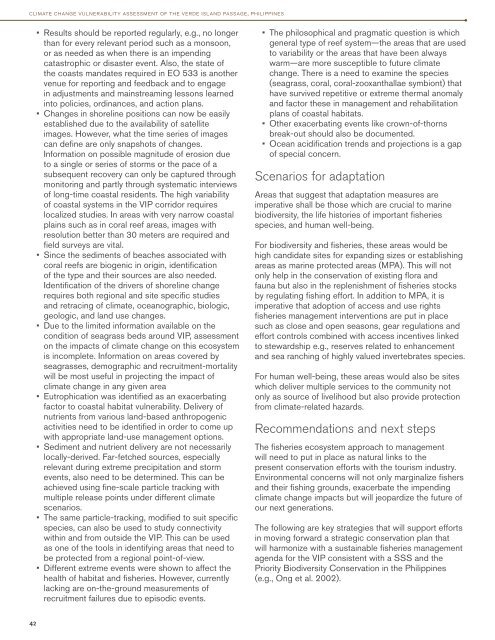of the Verde Island Passage, Philippines - weADAPT
of the Verde Island Passage, Philippines - weADAPT
of the Verde Island Passage, Philippines - weADAPT
Create successful ePaper yourself
Turn your PDF publications into a flip-book with our unique Google optimized e-Paper software.
climate change vulnerability assessment <strong>of</strong> <strong>the</strong> verde island passage, philippines<br />
• Results should be reported regularly, e.g., no longer<br />
than for every relevant period such as a monsoon,<br />
or as needed as when <strong>the</strong>re is an impending<br />
catastrophic or disaster event. Also, <strong>the</strong> state <strong>of</strong><br />
<strong>the</strong> coasts mandates required in EO 533 is ano<strong>the</strong>r<br />
venue for reporting and feedback and to engage<br />
in adjustments and mainstreaming lessons learned<br />
into policies, ordinances, and action plans.<br />
• Changes in shoreline positions can now be easily<br />
established due to <strong>the</strong> availability <strong>of</strong> satellite<br />
images. However, what <strong>the</strong> time series <strong>of</strong> images<br />
can define are only snapshots <strong>of</strong> changes.<br />
Information on possible magnitude <strong>of</strong> erosion due<br />
to a single or series <strong>of</strong> storms or <strong>the</strong> pace <strong>of</strong> a<br />
subsequent recovery can only be captured through<br />
monitoring and partly through systematic interviews<br />
<strong>of</strong> long-time coastal residents. The high variability<br />
<strong>of</strong> coastal systems in <strong>the</strong> VIP corridor requires<br />
localized studies. In areas with very narrow coastal<br />
plains such as in coral reef areas, images with<br />
resolution better than 30 meters are required and<br />
field surveys are vital.<br />
• Since <strong>the</strong> sediments <strong>of</strong> beaches associated with<br />
coral reefs are biogenic in origin, identification<br />
<strong>of</strong> <strong>the</strong> type and <strong>the</strong>ir sources are also needed.<br />
Identification <strong>of</strong> <strong>the</strong> drivers <strong>of</strong> shoreline change<br />
requires both regional and site specific studies<br />
and retracing <strong>of</strong> climate, oceanographic, biologic,<br />
geologic, and land use changes.<br />
• Due to <strong>the</strong> limited information available on <strong>the</strong><br />
condition <strong>of</strong> seagrass beds around VIP, assessment<br />
on <strong>the</strong> impacts <strong>of</strong> climate change on this ecosystem<br />
is incomplete. Information on areas covered by<br />
seagrasses, demographic and recruitment-mortality<br />
will be most useful in projecting <strong>the</strong> impact <strong>of</strong><br />
climate change in any given area<br />
• Eutrophication was identified as an exacerbating<br />
factor to coastal habitat vulnerability. Delivery <strong>of</strong><br />
nutrients from various land-based anthropogenic<br />
activities need to be identified in order to come up<br />
with appropriate land-use management options.<br />
• Sediment and nutrient delivery are not necessarily<br />
locally-derived. Far-fetched sources, especially<br />
relevant during extreme precipitation and storm<br />
events, also need to be determined. This can be<br />
achieved using fine-scale particle tracking with<br />
multiple release points under different climate<br />
scenarios.<br />
• The same particle-tracking, modified to suit specific<br />
species, can also be used to study connectivity<br />
within and from outside <strong>the</strong> VIP. This can be used<br />
as one <strong>of</strong> <strong>the</strong> tools in identifying areas that need to<br />
be protected from a regional point-<strong>of</strong>-view.<br />
• Different extreme events were shown to affect <strong>the</strong><br />
health <strong>of</strong> habitat and fisheries. However, currently<br />
lacking are on-<strong>the</strong>-ground measurements <strong>of</strong><br />
recruitment failures due to episodic events.<br />
• The philosophical and pragmatic question is which<br />
general type <strong>of</strong> reef system—<strong>the</strong> areas that are used<br />
to variability or <strong>the</strong> areas that have been always<br />
warm—are more susceptible to future climate<br />
change. There is a need to examine <strong>the</strong> species<br />
(seagrass, coral, coral-zooxanthallae symbiont) that<br />
have survived repetitive or extreme <strong>the</strong>rmal anomaly<br />
and factor <strong>the</strong>se in management and rehabilitation<br />
plans <strong>of</strong> coastal habitats.<br />
• O<strong>the</strong>r exacerbating events like crown-<strong>of</strong>-thorns<br />
break-out should also be documented.<br />
• Ocean acidification trends and projections is a gap<br />
<strong>of</strong> special concern.<br />
Scenarios for adaptation<br />
Areas that suggest that adaptation measures are<br />
imperative shall be those which are crucial to marine<br />
biodiversity, <strong>the</strong> life histories <strong>of</strong> important fisheries<br />
species, and human well-being.<br />
For biodiversity and fisheries, <strong>the</strong>se areas would be<br />
high candidate sites for expanding sizes or establishing<br />
areas as marine protected areas (MPA). This will not<br />
only help in <strong>the</strong> conservation <strong>of</strong> existing flora and<br />
fauna but also in <strong>the</strong> replenishment <strong>of</strong> fisheries stocks<br />
by regulating fishing effort. In addition to MPA, it is<br />
imperative that adoption <strong>of</strong> access and use rights<br />
fisheries management interventions are put in place<br />
such as close and open seasons, gear regulations and<br />
effort controls combined with access incentives linked<br />
to stewardship e.g., reserves related to enhancement<br />
and sea ranching <strong>of</strong> highly valued invertebrates species.<br />
For human well-being, <strong>the</strong>se areas would also be sites<br />
which deliver multiple services to <strong>the</strong> community not<br />
only as source <strong>of</strong> livelihood but also provide protection<br />
from climate-related hazards.<br />
Recommendations and next steps<br />
The fisheries ecosystem approach to management<br />
will need to put in place as natural links to <strong>the</strong><br />
present conservation efforts with <strong>the</strong> tourism industry.<br />
Environmental concerns will not only marginalize fishers<br />
and <strong>the</strong>ir fishing grounds, exacerbate <strong>the</strong> impending<br />
climate change impacts but will jeopardize <strong>the</strong> future <strong>of</strong><br />
our next generations.<br />
The following are key strategies that will support efforts<br />
in moving forward a strategic conservation plan that<br />
will harmonize with a sustainable fisheries management<br />
agenda for <strong>the</strong> VIP consistent with a SSS and <strong>the</strong><br />
Priority Biodiversity Conservation in <strong>the</strong> <strong>Philippines</strong><br />
(e.g., Ong et al. 2002).<br />
42
















